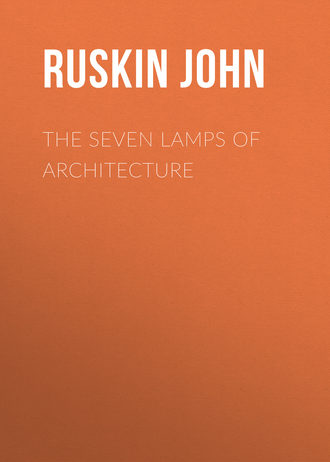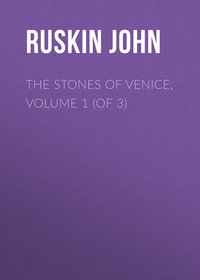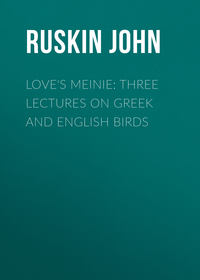 полная версия
полная версияThe Seven Lamps of Architecture
But the moment that the conditions of weight are comprehended, both truth and feeling require that the conditions of support should be also comprehended. Nothing can be worse, either as judged by the taste or the conscience, than affectedly inadequate supports—suspensions in air, and other such tricks and vanities. Mr. Hope wisely reprehends, for this reason, the arrangement of the main piers of St. Sophia at Constantinople. King's College Chapel, Cambridge, is a piece of architectural juggling, if possible still more to be condemned, because less sublime.
VIII. With deceptive concealments of structure are to be classed, though still more blameable, deceptive assumptions of it—the introduction of members which should have, or profess to have, a duty, and have none. One of the most general instances of this will be found in the form of the flying buttress in late Gothic. The use of that member is, of course, to convey support from one pier to another when the plan of the building renders it necessary or desirable that the supporting masses should be divided into groups, the most frequent necessity of this kind arising from the intermediate range of chapels or aisles between the nave or choir walls and their supporting piers. The natural, healthy, and beautiful arrangement is that of a steeply sloping bar of stone, sustained by an arch with its spandril carried farthest down on the lowest side, and dying into the vertical of the outer pier; that pier being, of course, not square, but rather a piece of wall set at right angles to the supported walls, and, if need be, crowned by a pinnacle to give it greater weight. The whole arrangement is exquisitely carried out in the choir of Beauvais. In later Gothic the pinnacle became gradually a decorative member, and was used in all places merely for the sake of its beauty. There is no objection to this; it is just as lawful to build a pinnacle for its beauty as a tower; but also the buttress became a decorative member; and was used, first, where it was not wanted, and, secondly, in forms in which it could be of no use, becoming a mere tie, not between the pier and wall, but between the wall and the top of the decorative pinnacle, thus attaching itself to the very point where its thrust, if it made any, could not be resisted. The most flagrant instance of this barbarism that I remember (though it prevails partially in all the spires of the Netherlands), is the lantern of St. Ouen at Rouen, where the pierced buttress, having an ogee curve, looks about as much calculated to bear a thrust as a switch of willow; and the pinnacles, huge and richly decorated, have evidently no work to do whatsoever, but stand round the central tower, like four idle servants, as they are—heraldic supporters, that central tower being merely a hollow crown, which needs no more buttressing than a basket does. In fact, I do not know anything more strange or unwise than the praise lavished upon this lantern; it is one of the basest pieces of Gothic in Europe; its flamboyant traceries of the last and most degraded forms;5 and its entire plan and decoration resembling, and deserving little more credit than, the burnt sugar ornaments of elaborate confectionery. There are hardly any of the magnificent and serene constructions of the early Gothic which have not, in the course of time, been gradually thinned and pared away into these skeletons, which sometimes indeed, when their lines truly follow the structure of the original masses, have an interest like that of the fibrous framework of leaves from which the substance has been dissolved, but which are usually distorted as well as emaciated, and remain but the sickly phantoms and mockeries of things that were; they are to true architecture what the Greek ghost was to the armed and living frame; and the very winds that whistle through the threads of them, are to the diapasoned echoes of the ancient walls, as to the voice of the man was the pining of the spectre.6
IX. Perhaps the most fruitful source of these kinds of corruption which we have to guard against in recent times, is one which, nevertheless, comes in a "questionable shape," and of which it is not easy to determine the proper laws and limits; I mean the use of iron. The definition of the art of architecture, given in the first chapter, is independent of its materials: nevertheless, that art having been, up to the beginning of the present century, practised for the most part in clay, stone, or wood, it has resulted that the sense of proportion and the laws of structure have been based, the one altogether, the other in great part, on the necessities consequent on the employment of those materials; and that the entire or principal employment of metallic framework would, therefore, be generally felt as a departure from the first principles of the art. Abstractedly there appears no reason why iron should not be used as well as wood; and the time is probably near when a new system of architectural laws will be developed, adapted entirely to metallic construction. But I believe that the tendency of all present sympathy and association is to limit the idea of architecture to non-metallic work; and that not without reason. For architecture being in its perfection the earliest, as in its elements it is necessarily the first, of arts, will always precede, in any barbarous nation, the possession of the science necessary either for the obtaining or the management of iron. Its first existence and its earliest laws must, therefore, depend upon the use of materials accessible in quantity, and on the surface of the earth; that is to say, clay, wood, or stone: and as I think it cannot but be generally felt that one of the chief dignities of architecture is its historical use; and since the latter is partly dependent on consistency of style, it will be felt right to retain as far as may be, even in periods of more advanced science, the materials and principles of earlier ages.
X. But whether this be granted me or not, the fact is, that every idea respecting size, proportion, decoration, or construction, on which we are at present in the habit of acting or judging, depends on presupposition of such materials: and as I both feel myself unable to escape the influence of these prejudices, and believe that my readers will be equally so, it may be perhaps permitted to me to assume that true architecture does not admit iron as a constructive material,7 and that such works as the cast-iron central spire of Rouen Cathedral, or the iron roofs and pillars of our railway stations, and of some of our churches, are not architecture at all. Yet it is evident that metals may, and sometimes must, enter into the construction to a certain extent, as nails in wooden architecture, and therefore as legitimately rivets and solderings in stone; neither can we well deny to the Gothic architect the power of supporting statues, pinnacles, or traceries by iron bars; and if we grant this I do not see how we can help allowing Brunelleschi his iron chain around the dome of Florence, or the builders of Salisbury their elaborate iron binding of the central tower.8 If, however, we would not fall into the old sophistry of the grains of corn and the heap, we must find a rule which may enable us to stop somewhere. This rule is, I think, that metals may be used as a cement but not as a support. For as cements of other kinds are often so strong that the stones may easier be broken than separated, and the wall becomes a solid mass without for that reason losing the character of architecture, there is no reason why, when a nation has obtained the knowledge and practice of iron work, metal rods or rivets should not be used in the place of cement, and establish the same or a greater strength and adherence, without in any wise inducing departure from the types and system of architecture before established; nor does it make any difference except as to sightliness, whether the metal bands or rods so employed, be in the body of the wall or on its exterior, or set as stays and cross-bands; so only that the use of them be always and distinctly one which might be superseded by mere strength of cement; as for instance if a pinnacle or mullion be propped or tied by an iron band, it is evident that the iron only prevents the separation of the stones by lateral force, which the cement would have done, had it been strong enough. But the moment that the iron in the least degree takes the place of the stone, and acts by its resistance to crushing, and bears superincumbent weight, or if it acts by its own weight as a counterpoise, and so supersedes the use of pinnacles or buttresses in resisting a lateral thrust, or if, in the form of a rod or girder, it is used to do what wooden beams would have done as well, that instant the building ceases, so far as such applications of metal extend, to be true architecture.
XI. The limit, however, thus determined, is an ultimate one, and it is well in all things to be cautious how we approach the utmost limit of lawfulness; so that, although the employment of metal within this limit cannot be considered as destroying the very being and nature of architecture, it will, if, extravagant and frequent, derogate from the dignity of the work, as well as (which is especially to our present point) from its honesty. For although the spectator is not informed as to the quantity or strength of the cement employed, he will generally conceive the stones of the building to be separable and his estimate of the skill of the architect will be based in a great measure on his supposition of this condition, and of the difficulties attendant upon it: so that it is always more honorable, and it has a tendency to render the style of architecture both more masculine and more scientific, to employ stone and mortar simply as such, and to do as much as possible with the weight of the one and the strength of the other, and rather sometimes to forego a grace, or to confess a weakness, than attain the one, or conceal the other, by means verging upon dishonesty.
Nevertheless, where the design is of such delicacy and slightness as, in some parts of very fair and finished edifices, it is desirable that it should be; and where both its completion and security are in a measure dependent on the use of metal, let not such use be reprehended; so only that as much is done as may be, by good mortar and good masonry; and no slovenly workmanship admitted through confidence in the iron helps; for it is in this license as in that of wine, a man may use it for his infirmities, but not for his nourishment.
XII. And, in order to avoid an over use of this liberty, it would be well to consider what application may be conveniently made of the dovetailing and various adjusting of stones; for when any artifice is necessary to help the mortar, certainly this ought to come before the use of metal, for it is both safer and more honest. I cannot see that any objection can be made to the fitting of the stones in any shapes the architect pleases: for although it would not be desirable to see buildings put together like Chinese puzzles, there must always be a check upon such an abuse of the practice in its difficulty; nor is it necessary that it should be always exhibited, so that it be understood by the spectator as an admitted help, and that no principal stones are introduced in positions apparently impossible for them to retain, although a riddle here and there, in unimportant features, may sometimes serve to draw the eye to the masonry, and make it interesting, as well as to give a delightful sense of a kind of necromantic power in the architect. There is a pretty one in the lintel of the lateral door of the cathedral of Prato (Plate IV. fig. 4.); where the maintenance of the visibly separate stones, alternate marble and serpentine, cannot be understood until their cross-cutting is seen below. Each block is, of course, of the form given in fig. 5.
XIII. Lastly, before leaving the subject of structural deceits, I would remind the architect who thinks that I am unnecessarily and narrowly limiting his resources or his art, that the highest greatness and the highest wisdom are shown, the first by a noble submission to, the second by a thoughtful providence for, certain voluntarily admitted restraints. Nothing is more evident than this, in that supreme government which is the example, as it is the centre, of all others. The Divine Wisdom is, and can be, shown to us only in its meeting and contending with the difficulties which are voluntarily, and for the sake of that contest, admitted by the Divine Omnipotence: and these difficulties, observe, occur in the form of natural laws or ordinances, which might, at many times and in countless ways, be infringed with apparent advantage, but which are never infringed, whatever costly arrangements or adaptations their observance may necessitate for the accomplishment of given purposes. The example most apposite to our present subject is the structure of the bones of animals. No reason can be given, I believe, why the system of the higher animals should not have been made capable, as that of the Infusoria is, of secreting flint, instead of phosphate of lime, or more naturally still, carbon; so framing the bones of adamant at once. The elephant or rhinoceros, had the earthy part of their bones been made of diamond, might have been as agile and light as grasshoppers, and other animals might have been framed far more magnificently colossal than any that walk the earth. In other worlds we may, perhaps, see such creations; a creation for every element, and elements infinite. But the architecture of animals here, is appointed by God to be a marble architecture, not a flint nor adamant architecture; and all manner of expedients are adopted to attain the utmost degree of strength and size possible under that great limitation. The jaw of the ichthyosaurus is pieced and riveted, the leg of the megatherium is a foot thick, and the head of the myodon has a double skull; we, in our wisdom, should, doubtless, have given the lizard a steel jaw, and the myodon a cast-iron headpiece, and forgotten the great principle to which all creation bears witness, that order and system are nobler things than power. But God shows us in Himself, strange as it may seem, not only authoritative perfection, but even the perfection of Obedience—an obedience to His own laws: and in the cumbrous movement of those unwieldiest of His creatures we are reminded, even in His divine essence, of that attribute of uprightness in the human creature "that sweareth to his own hurt and changeth not."
XIV. 2d. Surface Deceits. These may be generally defined as the inducing the supposition of some form or material which does not actually exist; as commonly in the painting of wood to represent marble, or in the painting of ornaments in deceptive relief, &c. But we must be careful to observe, that the evil of them consists always in definitely attempted deception, and that it is a matter of some nicety to mark the point where deception begins or ends.
Thus, for instance, the roof of Milan Cathedral is seemingly covered with elaborate fan tracery, forcibly enough painted to enable it, in its dark and removed position, to deceive a careless observer. This is, of course, gross degradation; it destroys much of the dignity even of the rest of the building, and is in the very strongest terms to be reprehended.
The roof of the Sistine Chapel has much architectural design in grissaille mingled with the figures of its frescoes; and the effect is increase of dignity.
In what lies the distinctive character?
In two points, principally:—First. That the architecture is so closely associated with the figures, and has so grand fellowship with them in its forms and cast shadows, that both are at once felt to be of a piece; and as the figures must necessarily be painted, the architecture is known to be so too. There is thus no deception.
Second. That so great a painter as Michael Angelo would always stop short in such minor parts of his design, of the degree of vulgar force which would be necessary to induce the supposition of their reality; and, strangely as it may sound, would never paint badly enough to deceive.
But though right and wrong are thus found broadly opposed in works severally so mean and so mighty as the roof of Milan and that of the Sistine, there are works neither so great nor so mean, in which the limits of right are vaguely defined, and will need some care to determine; care only, however, to apply accurately the broad principle with which we set out, that no form nor material is to be deceptively represented.
XV. Evidently, then, painting, confessedly such, is no deception: it does not assert any material whatever. Whether it be on wood or on stone, or, as will naturally be supposed, on plaster, does not matter. Whatever the material, good painting makes it more precious; nor can it ever be said to deceive respecting the ground of which it gives us no information. To cover brick with plaster, and this plaster with fresco, is, therefore, perfectly legitimate; and as desirable a mode of decoration as it is constant in the great periods. Verona and Venice are now seen deprived of more than half their former splendor; it depended far more on their frescoes than their marbles. The plaster, in this case, is to be considered as the gesso ground on panel or canvas. But to cover brick with cement, and to divide this cement with joints that it may look like stone, is to tell a falsehood; and is just as contemptible a procedure as the other is noble.
It being lawful to paint then, is it lawful to paint everything? So long as the painting is confessed—yes; but if, even in the slightest degree, the sense of it be lost, and the thing painted be supposed real—no. Let us take a few instances. In the Campo Santo at Pisa, each fresco is surrounded with a border composed of flat colored patterns of great elegance—no part of it in attempted relief. The certainty of flat surface being thus secured, the figures, though the size of life, do not deceive, and the artist thenceforward is at liberty to put forth his whole power, and to lead us through fields and groves, and depths of pleasant landscape, and to soothe us with the sweet clearness of far off sky, and yet never lose the severity of his primal purpose of architectural decoration.
In the Camera di Correggio of San Lodovico at Parma, the trellises of vine shadow the walls, as if with an actual arbor; and the troops of children, peeping through the oval openings, luscious in color and faint in light, may well be expected every instant to break through, or hide behind the covert. The grace of their attitudes, and the evident greatness of the whole work, mark that it is painting, and barely redeem it from the charge of falsehood; but even so saved, it is utterly unworthy to take a place among noble or legitimate architectural decoration.
In the cupola of the duomo of Parma the same painter has represented the Assumption with so much deceptive power, that he has made a dome of some thirty feet diameter look like a cloud-wrapt opening in the seventh heaven, crowded with a rushing sea of angels. Is this wrong? Not so: for the subject at once precludes the possibility of deception. We might have taken the vines for a veritable pergoda, and the children for its haunting ragazzi; but we know the stayed clouds and moveless angels must be man's work; let him put his utmost strength to it and welcome, he can enchant us, but cannot betray.
We may thus apply the rule to the highest, as well as the art of daily occurrence, always remembering that more is to be forgiven to the great painter than to the mere decorative workman; and this especially, because the former, even in deceptive portions, will not trick us so grossly; as we have just seen in Correggio, where a worse painter would have made the thing look like life at once. There is, however, in room, villa, or garden decoration, some fitting admission of trickeries of this kind, as of pictured landscapes at the extremities of alleys and arcades, and ceilings like skies, or painted with prolongations upwards of the architecture of the walls, which things have sometimes a certain luxury and pleasureableness in places meant for idleness, and are innocent enough as long as they are regarded as mere toys.
XVI. Touching the false representation of material, the question is infinitely more simple, and the law more sweeping; all such imitations are utterly base and inadmissible. It is melancholy to think of the time and expense lost in marbling the shop fronts of London alone, and of the waste of our resources in absolute vanities, in things about which no mortal cares, by which no eye is ever arrested, unless painfully, and which do not add one whit to comfort or cleanliness, or even to that great object of commercial art—conspicuousness. But in architecture of a higher rank, how much more is it to be condemned? I have made it a rule in the present work not to blame specifically; but I may, perhaps, be permitted, while I express my sincere admiration of the very noble entrance and general architecture of the British Museum, to express also my regret that the noble granite foundation of the staircase should be mocked at its landing by an imitation, the more blameable because tolerably successful. The only effect of it is to cast a suspicion upon the true stones below, and upon every bit of granite afterwards encountered. One feels a doubt, after it, of the honesty of Memnon himself. But even this, however derogatory to the noble architecture around it, is less painful than the want of feeling with which, in our cheap modern churches, we suffer the wall decorator to erect about the altar frameworks and pediments daubed with mottled color, and to dye in the same fashions such skeletons or caricatures of columns as may emerge above the pews; this is not merely bad taste; it is no unimportant or excusable error which brings even these shadows of vanity and falsehood into the house of prayer. The first condition which just feeling requires in church furniture is, that it should be simple and unaffected, not fictitious nor tawdry. It may be in our power to make it beautiful, but let it at least be pure; and if we cannot permit much to the architect, do not let us permit anything to the upholsterer; if we keep to solid stone and solid wood, whitewashed, if we like, for cleanliness' sake (for whitewash has so often been used as the dress of noble things that it has thence received a kind of nobility itself), it must be a bad design indeed which is grossly offensive. I recollect no instance of a want of sacred character, or of any marked and painful ugliness, in the simplest or the most awkwardly built village church, where stone and wood were roughly and nakedly used, and the windows latticed with white glass. But the smoothly stuccoed walls, the flat roofs with ventilator ornaments, the barred windows with jaundiced borders and dead ground square panes, the gilded or bronzed wood, the painted iron, the wretched upholstery of curtains and cushions, and pew heads and altar railings, and Birmingham metal candlesticks, and, above all, the green and yellow sickness of the false marble—disguises all, observe; falsehoods all—who are they who like these things? who defend them? who do them? I have never spoken to any one who did like them, though to many who thought them matters of no consequence. Perhaps not to religion (though I cannot but believe that there are many to whom, as to myself, such things are serious obstacles to the repose of mind and temper which should precede devotional exercises); but to the general tone of our judgment and feeling—yes; for assuredly we shall regard, with tolerance, if not with affection, whatever forms of material things we have been in the habit of associating with our worship, and be little prepared to detect or blame hypocrisy, meanness, and disguise in other kinds of decoration when we suffer objects belonging to the most solemn of all services to be tricked out in a fashion so fictitious and unseemly.
XVII. Painting, however, is not the only mode in which material may be concealed, or rather simulated; for merely to conceal is, as we have seen, no wrong. Whitewash, for instance, though often (by no means always) to be regretted as a concealment, is not to be blamed as a falsity. It shows itself for what it is, and asserts nothing of what is beneath it. Gilding has become, from its frequent use, equally innocent. It is understood for what it is, a film merely, and is, therefore, allowable to any extent. I do not say expedient: it is one of the most abused means of magnificence we possess, and I much doubt whether any use we ever make of it, balances that loss of pleasure, which, from the frequent sight and perpetual suspicion of it, we suffer in the contemplation of anything that is verily of gold. I think gold was meant to be seldom seen and to be admired as a precious thing; and I sometimes wish that truth should so far literally prevail as that all should be gold that glittered, or rather that nothing should glitter that was not gold. Nevertheless, nature herself does not dispense with such semblance, but uses light for it; and I have too great a love for old and saintly art to part with its burnished field, or radiant nimbus; only it should be used with respect, and to express magnificence, or sacredness, and not in lavish vanity, or in sign painting. Of its expedience, however, any more than of that of color, it is not here the place to speak; we are endeavoring to determine what is lawful, not what is desirable. Of other and less common modes of disguising surface, as of powder of lapis lazuli, or mosaic imitations of colored stones, I need hardly speak. The rule will apply to all alike, that whatever is pretended, is wrong; commonly enforced also by the exceeding ugliness and insufficient appearance of such methods, as lately in the style of renovation by which half the houses in Venice have been defaced, the brick covered first with stucco, and this painted with zigzag veins in imitation of alabaster. But there is one more form of architectural fiction, which is so constant in the great periods that it needs respectful judgment. I mean the facing of brick with precious stone.











